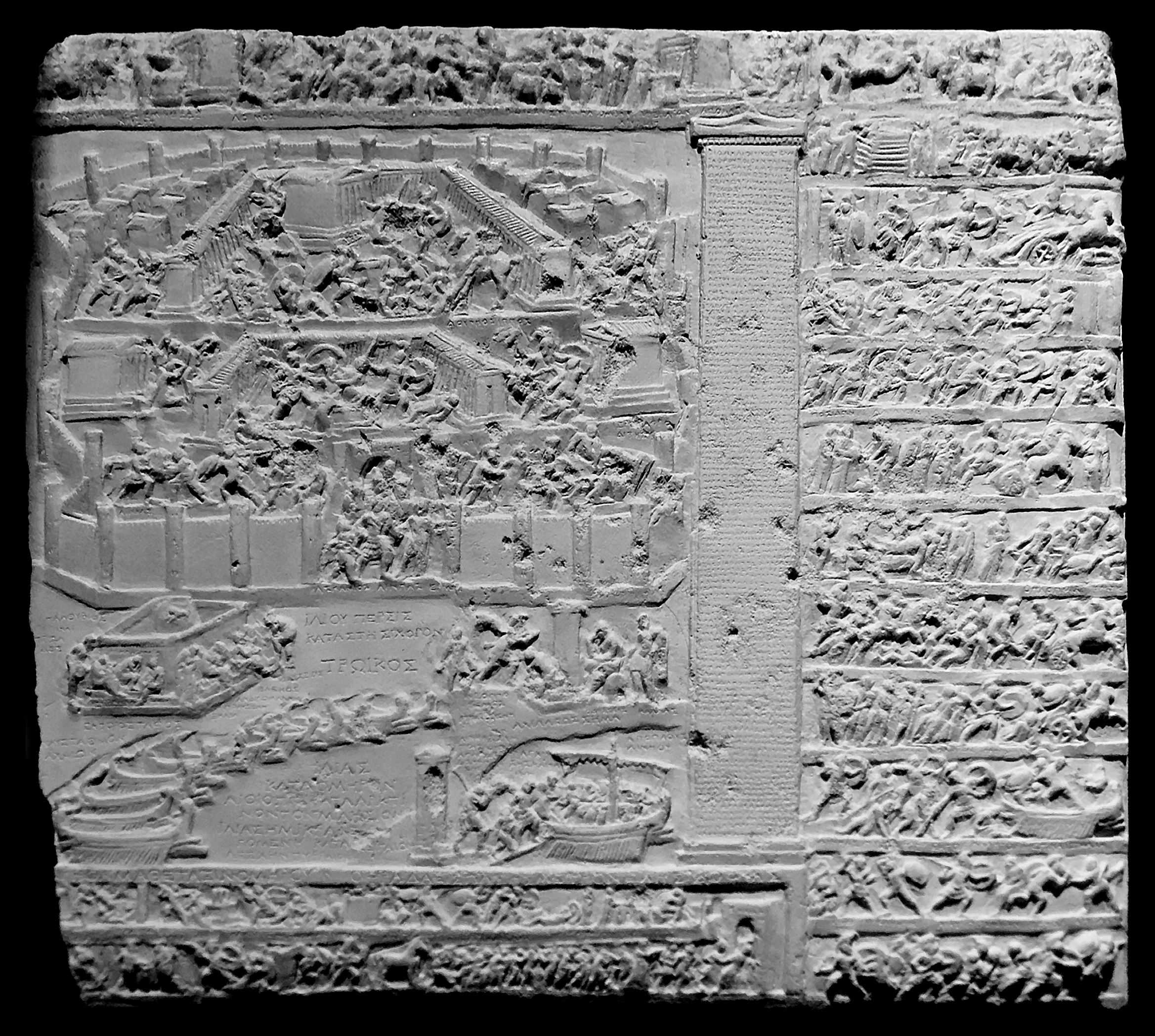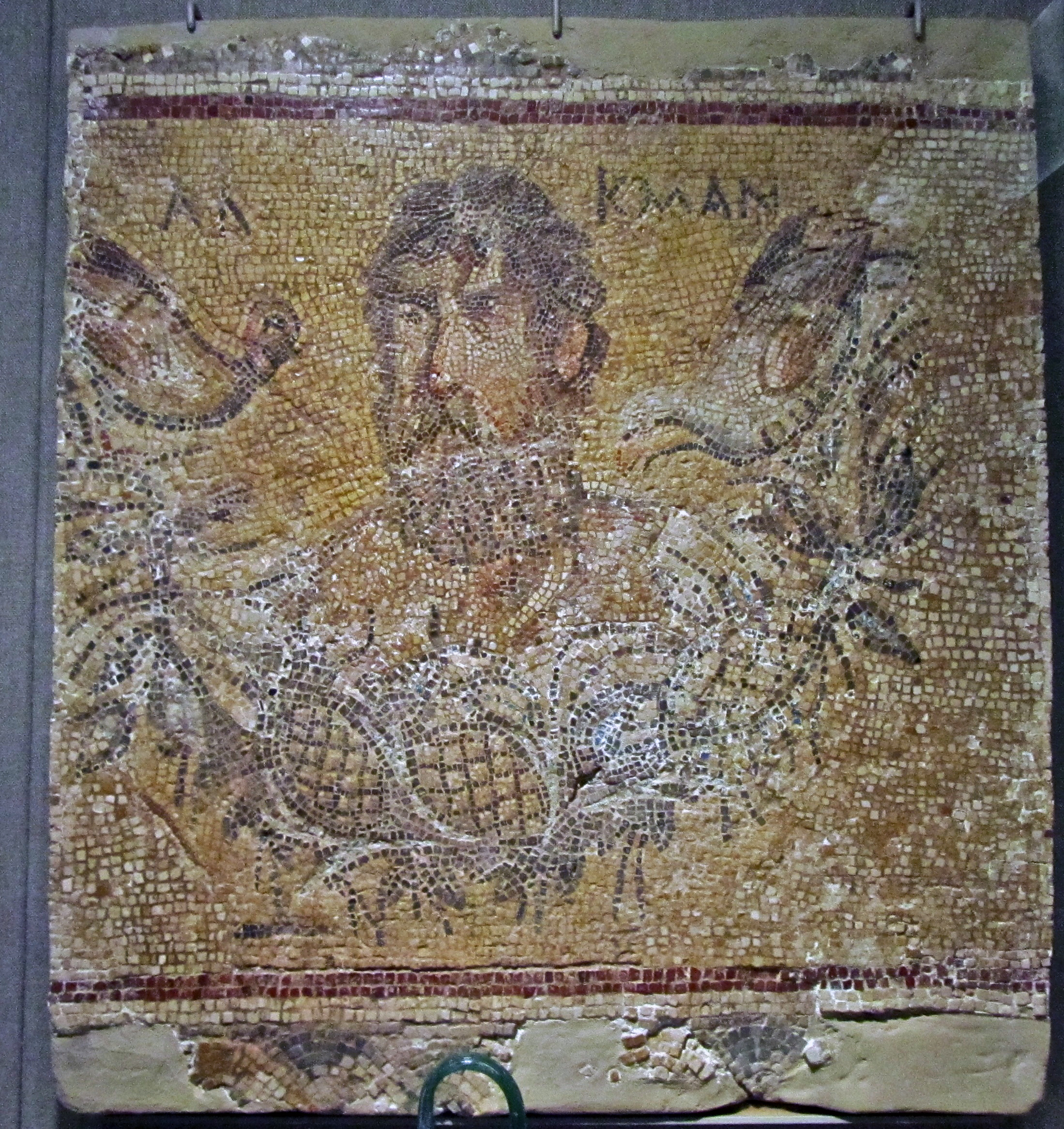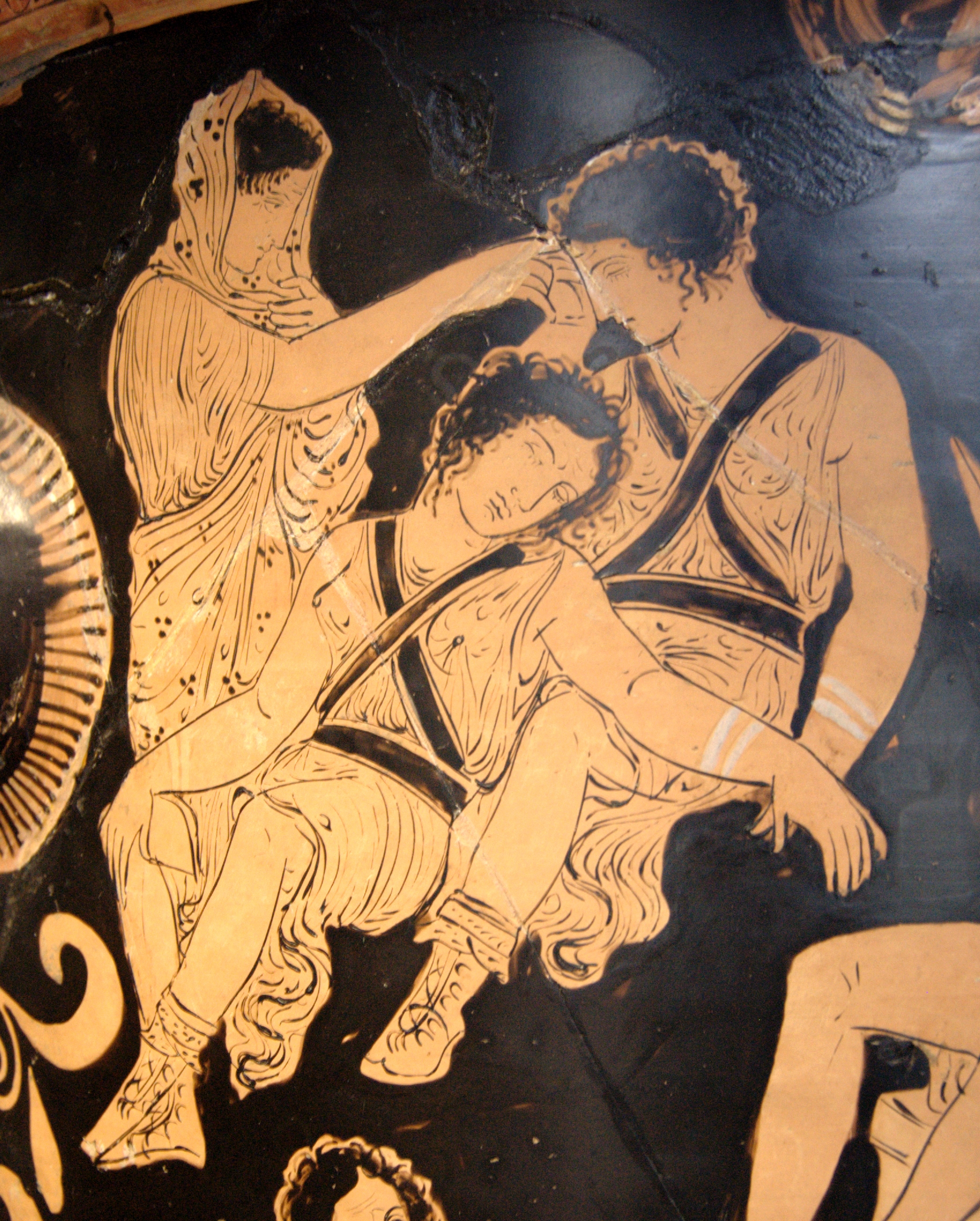|
Balius And Xanthus
Balius (; Ancient Greek: Βάλιος, ''Balios'', possibly "dappled") and Xanthus (; Ancient Greek: Ξάνθος, ''Xanthos'', "blonde") were, according to Greek mythology, two immortal horses, the offspring of the harpy, Podarge and the West wind, Zephyrus. In other traditions, Poseidon is the father of Xanthus along with another horse named Cyllarus to an unnamed mother. It is possible that Xanthus's ability to speak prophetically may be related to Arion, another mythical horse reported to have saved Adrastus from the war of the Seven against Thebes with his prophetic abilities in Statius's ''Thebaid''. Mythology Poseidon gave the two horses to King Peleus of Phthia, as a wedding gift when Peleus married the Ocean goddess, Thetis. Peleus later gave the horses to his son Achilles who took them to draw his chariot during the Trojan War. Book 16 of the ''Iliad'' tells us that Achilles had a third horse, Pedasos (maybe "Jumper", maybe "Captive"), which was yoked as a "trace ... [...More Info...] [...Related Items...] OR: [Wikipedia] [Google] [Baidu] |
Automedon
In Greek mythology, Automedon (; Ancient Greek: Αὐτομέδων), son of Diores, was Achilles' charioteer, who drove the immortal horses Balius and Xanthos. Mythology In Homer's ''Iliad'', Automedon rides into battle once Patroclus dons Achilles's armor, commanding Achilles' horses Balius and Xanthos. After Patroclus dies, Automedon is driven to the rear of the battle, where he tries to console the bereaved horses. Zeus finally intervenes, and Automedon resumes driving the chariot, but cannot aid the Achaeans until Alcimedon agrees to be his driver. He repels an attempt on his life by Hector, Aeneas, Chromios, and Aretos, killing Aretos''The New Century Classical Handbook''; Catherine Avery, editor; Appleton-Century-Crofts, New York, 1962, p. 144: "Aretus...was slain by Achilles' charioteer, Automedon" and taking his armor in the process. He also appears in the ''Aeneid'' at line 477 of Book II, when the Greek forces break into the palace of Priam. Notes References ... [...More Info...] [...Related Items...] OR: [Wikipedia] [Google] [Baidu] |
Trojan War
In Greek mythology, the Trojan War was waged against the city of Troy by the Achaeans (Greeks) after Paris of Troy took Helen from her husband Menelaus, king of Sparta. The war is one of the most important events in Greek mythology and has been narrated through many works of Greek literature, most notably Homer's ''Iliad''. The core of the ''Iliad'' (Books II – XXIII) describes a period of four days and two nights in the tenth year of the decade-long siege of Troy; the ''Odyssey'' describes the journey home of Odysseus, one of the war's heroes. Other parts of the war are described in a cycle of epic poems, which have survived through fragments. Episodes from the war provided material for Greek tragedy and other works of Greek literature, and for Roman poets including Virgil and Ovid. The ancient Greeks believed that Troy was located near the Dardanelles and that the Trojan War was a historical event of the 13th or 12th century BC, but by the mid-19th century AD, both the ... [...More Info...] [...Related Items...] OR: [Wikipedia] [Google] [Baidu] |
Horses In Mythology
The horse (''Equus ferus caballus'') is a domesticated, one-toed, hoofed mammal. It belongs to the taxonomic family Equidae and is one of two extant subspecies of ''Equus ferus''. The horse has evolved over the past 45 to 55 million years from a small multi-toed creature, ''Eohippus'', into the large, single-toed animal of today. Humans began domesticating horses around 4000 BCE, and their domestication is believed to have been widespread by 3000 BCE. Horses in the subspecies ''caballus'' are domesticated, although some domesticated populations live in the wild as feral horses. These feral populations are not true wild horses, as this term is used to describe horses that have never been domesticated. There is an extensive, specialized vocabulary used to describe equine-related concepts, covering everything from anatomy to life stages, size, colors, markings, breeds, locomotion, and behavior. Horses are adapted to run, allowing them to quickly escape predators, and ... [...More Info...] [...Related Items...] OR: [Wikipedia] [Google] [Baidu] |
Characters In The Iliad
This is a list of principal characters in Homer's ''Iliad'' and ''Odyssey''. Greeks in the Trojan War *Achilles (), the leader of the Myrmidons (), son of Peleus and Thetis, and the principal Greek champion whose anger is one of the main elements of the story. *Agamemnon (), King of Mycenae, supreme commander of the Achaean armies whose actions provoke the feud with Achilles; elder brother of King Menelaus. *Ajax or Aias (), also known as Telamonian Ajax (he was the son of Telamon) and Greater Ajax, was the tallest and strongest warrior (after Achilles) to fight for the Achaeans. *Ajax the Lesser, an Achaean commander, son of Oileus often fights alongside Great Ajax; the two together are sometimes called the "Ajaxes" (, ''Aiante''). * Antilochus (Ἀντίλοχος), son of Nestor sacrificed himself to save his father in the Trojan War along with other deeds of valor * Calchas (), a powerful Greek prophet and omen reader, who guided the Greeks through the war with his prediction ... [...More Info...] [...Related Items...] OR: [Wikipedia] [Google] [Baidu] |
Apostolos Athanassakis
Apostolos N. Athanassakis ( el, Αποστολος Αθανασάκης) is a classical scholar and formerly Argyropoulos Chair in Hellenic Studies at the University of California, Santa Barbara (UCSB). Professor Athanassakis, or "Professor A" as he is often referred to by students, served as the faculty in residence in Manzanita Village. Athanassakis taught at UCSB for nearly 30 years in the Classics Department. From 1984 to 1986 he served as head of the Humanities Division at the University of Crete, in Greece. Bibliography * ''Apocolocyntosis divi Claudii'' (translation, introduction and commentary, 1973) *''The Homeric Hymns'' (translation, introduction and notes). Baltimore, MD; Johns Hopkins University Press, 1976. * ''Vita Sancti Pachomii'' (translation and introduction, 1977) * ''Hesiod: Theogony, Works and Days and Shield of Heracles'' (translation, introduction and commentary, 1983) * ''Essays on Hesiod, Volume I'' (editor, 1992) * ''Essays on Hesiod, Volume II'' (editor a ... [...More Info...] [...Related Items...] OR: [Wikipedia] [Google] [Baidu] |
Castor And Pollux
Castor; grc, Κάστωρ, Kástōr, beaver. and Pollux. (or Polydeukes). are twin half-brothers in Greek and Roman mythology, known together as the Dioscuri.; grc, Διόσκουροι, Dióskouroi, sons of Zeus, links=no, from ''Dîos'' ('Zeus') and '' koûroi'' ('boys'). Their mother was Leda, but they had different fathers; Castor was the mortal son of Tyndareus, the king of Sparta, while Pollux was the divine son of Zeus, who raped Leda in the guise of a swan. The pair are thus an example of heteropaternal superfecundation. Though accounts of their birth are varied, they are sometimes said to have been born from an egg, along with their twin sisters Helen of Troy and Clytemnestra. In Latin the twins are also known as the Gemini (literally "twins") or Castores, as well as the Tyndaridae or Tyndarids.. Pollux asked Zeus to let him share his own immortality with his twin to keep them together, and they were transformed into the constellation Gemini. The pair were regarded ... [...More Info...] [...Related Items...] OR: [Wikipedia] [Google] [Baidu] |
Stesichorus
Stesichorus (; grc-gre, Στησίχορος, ''Stēsichoros''; c. 630 – 555 BC) was a Greek lyric poet native of today's Calabria (Southern Italy). He is best known for telling epic stories in lyric metres, and for some ancient traditions about his life, such as his opposition to the tyrant Phalaris, and the blindness he is said to have incurred and cured by composing verses first insulting and then flattering to Helen of Troy. He was ranked among the nine lyric poets esteemed by the scholars of Hellenistic Alexandria, and yet his work attracted relatively little interest among ancient commentators, so that remarkably few fragments of his poetry now survive. As David Campbell notes: "Time has dealt more harshly with Stesichorus than with any other major lyric poet." Recent discoveries, recorded on Egyptian papyrus (notably and controversially, the Lille Stesichorus),P.J. Parsons, "The Lille Stesichorus", ''Zeitschreift für Papyrologie und Epigraphik'' Vol. 26 (1977), pages 7� ... [...More Info...] [...Related Items...] OR: [Wikipedia] [Google] [Baidu] |
Alcman
Alcman (; grc-gre, Ἀλκμάν ''Alkmán''; fl. 7th century BC) was an Ancient Greek choral lyric poet from Sparta. He is the earliest representative of the Alexandrian canon of the Nine Lyric Poets. Biography Alcman's dates are uncertain, but he was probably active in the late seventh century BC. The name of his mother is not known; his father may have been called either Damas or Titarus. Alcman's nationality was disputed even in antiquity. Unfortunately, the records of the ancient authors were often deduced from biographic readings of their poetry, and the details are often untrustworthy. Antipater of Thessalonica wrote that poets have "many mothers" and that the continents of Europe and Asia both claimed Alcman as their son. Frequently assumed to have been born in Sardis, capital of ancient Lydia, the Suda claims that Alcman was actually a Laconian from Messoa. The compositeness of his dialect may have helped to maintain the uncertainty of his origins, but the ... [...More Info...] [...Related Items...] OR: [Wikipedia] [Google] [Baidu] |
Erinyes
The Erinyes ( ; sing. Erinys ; grc, Ἐρινύες, pl. of ), also known as the Furies, and the Eumenides, were female chthonic deities of vengeance in ancient Greek religion and mythology. A formulaic oath in the ''Iliad'' invokes them as "the Erinyes, that under earth take vengeance on men, whosoever hath sworn a false oath". Walter Burkert suggests that they are "an embodiment of the act of self-cursing contained in the oath". They correspond to the Dirae in Roman mythology. The Roman writer Maurus Servius Honoratus wrote (ca. 400 AD) that they are called "Eumenides" in hell, "Furiae" on Earth, and "Dirae" in heaven. Erinyes are akin to some other Greek deities, called Poenai. According to Hesiod's ''Theogony'', when the Titan Cronus castrated his father, Uranus, and threw his genitalia into the sea, the Erinyes (along with the Giants and the Meliae) emerged from the drops of blood which fell on the Earth ( Gaia), while Aphrodite was born from the crests of sea ... [...More Info...] [...Related Items...] OR: [Wikipedia] [Google] [Baidu] |
Hera
In ancient Greek religion, Hera (; grc-gre, Ἥρα, Hḗrā; grc, Ἥρη, Hḗrē, label=none in Ionic and Homeric Greek) is the goddess of marriage, women and family, and the protector of women during childbirth. In Greek mythology, she is queen of the twelve Olympians and Mount Olympus, sister and wife of Zeus, and daughter of the Titans Cronus and Rhea. One of her defining characteristics in myth is her jealous and vengeful nature in dealing with any who offend her, especially Zeus' numerous adulterous lovers and illegitimate offspring. Her iconography usually presents her as a dignified, matronly figure, upright or enthroned, crowned with a ''polos'' or diadem, sometimes veiled as a married woman. She is the patron goddess of lawful marriage. She presides over weddings, blesses and legalises marital unions, and protects women from harm during childbirth. Her sacred animals include the cow, cuckoo and the peacock. She is sometimes shown holding a pomegranate, as an ... [...More Info...] [...Related Items...] OR: [Wikipedia] [Google] [Baidu] |
Patroclus
In Greek mythology, as recorded in Homer's ''Iliad'', Patroclus (pronunciation variable but generally ; grc, Πάτροκλος, Pátroklos, glory of the father) was a childhood friend, close wartime companion, and the presumed (by some later ancient sources) lover of Achilles. of name There are at least three pronunciations of the name 'Patroclus' in English. Because the penultimate syllable is light in Latin prose (''pă′.trŏ.clŭs''), the antepenult was stressed in Latin and would normally be stressed in English as well, for (analogous to 'Sophocles'). However, this pronunciation is seldom encountered: for metrical convenience, Alexander Pope had made the 'o' long, and thus stressed, in his translation of Homer, following a convention of Greek and Latin verse, and that pronunciation – of Latin ''pa.trō′.clus'' – has stuck, for English . Moreover, because in prose a penultimate Greco-Latin short ''o'' (omicron) would only be stressed in a closed syllable, the pe ... [...More Info...] [...Related Items...] OR: [Wikipedia] [Google] [Baidu] |
Lycia
Lycia (Lycian language, Lycian: 𐊗𐊕𐊐𐊎𐊆𐊖 ''Trm̃mis''; el, Λυκία, ; tr, Likya) was a state or nationality that flourished in Anatolia from 15–14th centuries BC (as Lukka) to 546 BC. It bordered the Mediterranean Sea in what is today the Provinces of Turkey, provinces of Antalya Province, Antalya and Muğla Province, Muğla in Turkey as well some inland parts of Burdur Province. The state was known to history from the Late Bronze Age records of ancient Egypt and the Hittite Empire. Lycia was populated by speakers of the Luwian language group. Written records began to be inscribed in stone in the Lycian language (a later form of Luwian) after Lycia's involuntary incorporation into the Achaemenid Empire in the Iron Age. At that time (546 BC) the Luwian speakers were decimated, and Lycia received an influx of Persian speakers. Ancient sources seem to indicate that an older name of the region was Alope ( grc, Ἀλόπη}, ). The many cities in Ly ... [...More Info...] [...Related Items...] OR: [Wikipedia] [Google] [Baidu] |







_Pompeian_Art.jpg)

.jpg)